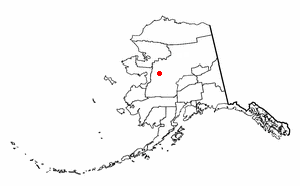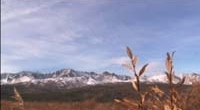
Interior Alaska is the central region of Alaska's territory, roughly bounded by the Alaska Range to the south and the Brooks Range to the north. It is largely wilderness. Mountains include Denali in the Alaska Range, the Wrangell Mountains, and the Ray Mountains. The native people of the interior are Alaskan Athabaskans. The largest city in the interior is Fairbanks, Alaska's second-largest city, in the Tanana Valley. Other towns include North Pole, just southeast of Fairbanks, Eagle, Tok, Glennallen, Delta Junction, Nenana, Anderson, Healy and Cantwell. The interior region has an estimated population of 113,154.

Yukon–Koyukuk Census Area is a census area in the U.S. state of Alaska. As of the 2020 census, the population was 5,343, down from 5,588 in 2010. With an area of 147,842.51 sq mi (382,910.3 km2), it is the largest of any county or county-equivalent in the United States, or slightly larger than the entire state of Montana. It is part of the unorganized borough of Alaska and therefore has no borough seat. Its largest communities are the cities of Galena, in the west, and Fort Yukon, in the northeast.

Hughes is a city in Yukon-Koyukuk Census Area, Alaska, United States. The population was 85 at the 2020 census, up from 77 in 2010.

Koyukuk is a city in Yukon-Koyukuk Census Area, Alaska, United States. At the 2010 census the population was 96, down from 101 in 2000.
Minto is a census-designated place (CDP) in Yukon-Koyukuk Census Area, Alaska, United States. As of the 2020 census, the population of the CDP is 150, down from 210 in 2010. The name is an anglicized version of the Lower Tanana Athabaskan name Menhti, meaning 'among the lakes'. After repeated flooding the village was relocated to its present location in 1969. The former village site is now known as Old Minto.

Nulato is a city in Yukon-Koyukuk Census Area, Alaska, United States. At the 2020 census, the population was 239.

Tanana is a city in the Yukon-Koyukuk Census Area in the U.S. state of Alaska. At the 2010 census the population was 246, down from 308 in 2000. It was formerly known as Clachotin, adopted by Canadian French.

Tanacross is an endangered Athabaskan language spoken by fewer than 60 people in eastern Interior Alaska.

Athabaskan is a large family of Indigenous languages of North America, located in western North America in three areal language groups: Northern, Pacific Coast and Southern. Kari and Potter (2010:10) place the total territory of the 53 Athabaskan languages at 4,022,000 square kilometres (1,553,000 sq mi).

The Koyukuk River is a 425-mile (684 km) tributary of the Yukon River, in the U.S. state of Alaska. It is the last major tributary entering the Yukon before the larger river empties into the Bering Sea.

The Koyukon, Dinaa, or Denaa are an Alaska Native Athabascan people of the Athabascan-speaking ethnolinguistic group. Their traditional territory is along the Koyukuk and Yukon rivers where they subsisted for thousands of years by hunting and trapping. Many Koyukon live in a similar manner today.
Holikachuk is a recently extinct Athabaskan language formerly spoken at the village of Holikachuk (Hiyeghelinhdi) on the Innoko River in central Alaska. In 1962, residents of Holikachuk relocated to Grayling on the lower Yukon River. Holikachuk is intermediate between the Deg Xinag and Koyukon languages, linguistically closer to Koyukon but socially much closer to Deg Xinag. Though it was recognized by scholars as a distinct language as early as the 1840s, it was only definitively identified in the 1970s. Of about 180 Holikachuk people, only about 5 spoke the language in 2007. In March 2012, the last living fluent speaker of Holikachuk died in Alaska.
James Kari is an American linguist and Professor Emeritus with the Alaska Native Language Center at the University of Alaska Fairbanks (UAF) specializing in the Dene of Alaska. He served on the faculty of UAF from 1973 to his retirement in 1997.

Chief David Salmon was an Indigenous Alaskan that served as Chief of Chalkyitsik and later First Traditional Chief for the Gwich'in people. He was known for his commitment to improving his community and working for the people. Salmon would use his position and influence as chief to begin many public works and create programs dedicated to helping the Gwich'in people. As an advocate for education, Salmon would spread his knowledge by creating traditional Athabascan items for display or teaching his community to keep Athabascan traditions alive. At the same time, Chief Salmon would be trained and become the first Episcopal priest for Interior Alaska and spend a lot of his life spreading his faith.
Kathleen Carlo-Kendall born in Tanana, Alaska, is a Koyukon Athabaskan professional carver from Alaska.

The Alaskan Athabascans, Alaskan Athapascans or Dena are Alaska Native peoples of the Athabaskan-speaking ethnolinguistic group. They are the original inhabitants of the interior of Alaska.

The Tanana Athabaskans, Tanana Athabascans, or Tanana Athapaskans are an Alaskan Athabaskan people from the Athabaskan-speaking ethnolinguistic group. They are the original inhabitants of the Tanana River drainage basin in east-central Alaska Interior, United States and a little part lived in Yukon, Canada. Tanana River Athabaskan peoples are called in Lower Tanana and Koyukon language Ten Hʉt'ænæ, in Gwich'in language Tanan Gwich'in. In Alaska, where they are the oldest, there are three or four groups identified by the languages they speak. These are the Tanana proper or Lower Tanana and/or Middle Tanana, Tanacross or Tanana Crossing, and Upper Tanana. The Tanana Athabaskan culture is a hunter-gatherer culture with a matrilineal system. Tanana Athabaskans were semi-nomadic and lived in semi-permanent settlements in the Tanana Valley lowlands. Traditional Athabaskan land use includes fall hunting of moose, caribou, Dall sheep, and small terrestrial animals, as well as trapping. The Athabaskans did not have any formal tribal organization. Tanana Athabaskans were strictly territorial and used hunting and gathering practices in their semi-nomadic way of life and dispersed habitation patterns. Each small band of 20–40 people normally had a central winter camp with several seasonal hunting and fishing camps, and they moved cyclically, depending on the season and availability of resources.
Arthur Harper (1835–1897) was an Irish-born Yukon River prospector, trader, and explorer, recognized as the first man to enter the Yukon country seeking gold. He mined in California during the 1850s, and British Columbia during the 1860s, before travelling to the Yukon region in 1871. He reached Fort Yukon in 1873, and managed a store with Jack McQuesten at the Fortymile River. Harper formed a trading partnership with McQuesten and Captain Al Mayo; their company founded Fort Reliance in 1875 and other posts in the Yukon region. Harper was known as the best prospector of the trio, and while he did not achieve major success in his pursuit of gold, he sometimes directed others to finds. He traded and prospected in Alaska until just before his death.
Athabaskan fiddle is the old-time fiddle style that the Alaskan Athabaskans of the Interior Alaska have developed to play the fiddle (violin), solo and in folk ensembles. Fiddles were introduced in this area by Scottish, Irish, French Canadian, and Métis fur traders of the Hudson's Bay Company in the mid-19th century. Athabaskan fiddling is a variant of fiddling of the American southlands. Athabaskan fiddle music is most popular genre in Alaska and northwest Canada and featuring Gwich'in Bill Stevens and Trimble Gilbert.

Siri Tuttle is the former director of the Alaska Native Language Center, the Alaska Native Language Archive, and a former Associate Professor of Linguistics at the University of Alaska, Fairbanks. She specializes in Dene (Athabascan) languages of interior Alaska and has contributed to the fields of acoustic phonetics, phonology, and morphology. She retired in 2021.













